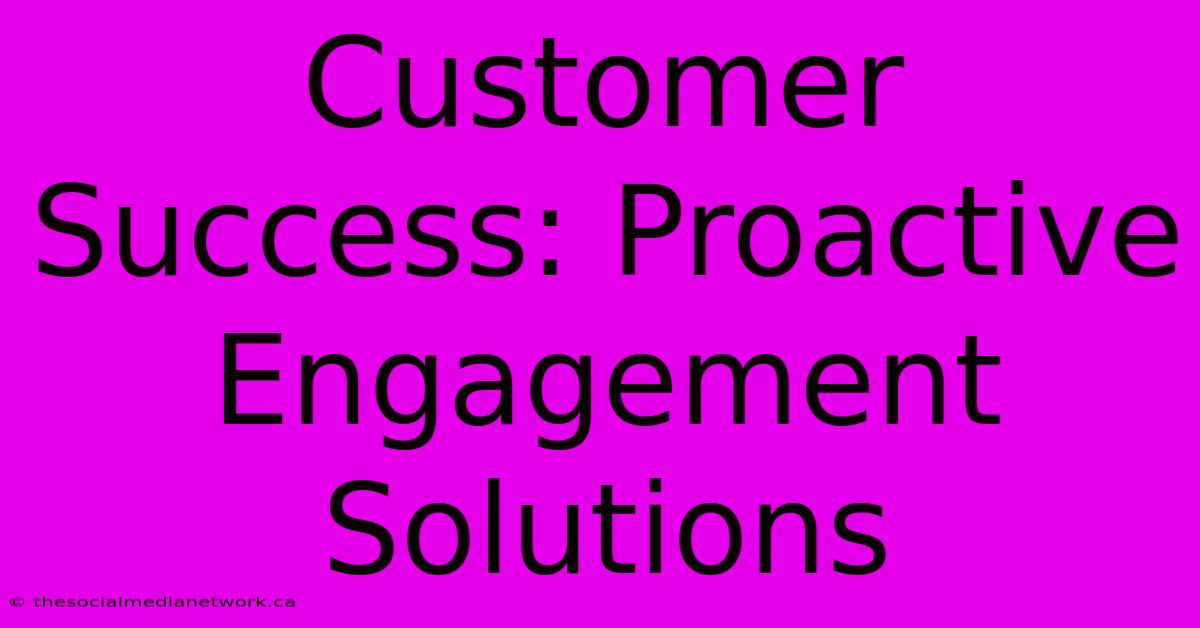Customer Success: Proactive Engagement Solutions

Discover more detailed and exciting information on our website. Click the link below to start your adventure: Visit Best Website meltwatermedia.ca. Don't miss out!
Table of Contents
Customer Success: Proactive Engagement Solutions
Is your customer success strategy reactive or proactive? In today's competitive landscape, simply reacting to customer issues isn't enough. Proactive engagement is the key to fostering long-term relationships, boosting customer lifetime value (CLTV), and driving sustainable growth. This article explores effective strategies for proactive customer engagement and how to build a robust customer success program.
Understanding Proactive Customer Engagement
Proactive customer engagement goes beyond responding to support tickets. It involves anticipating customer needs, identifying potential challenges, and reaching out before problems arise. This approach strengthens customer relationships, increases product adoption, and ultimately, leads to higher customer satisfaction and retention rates.
Key Benefits of a Proactive Approach:
- Improved Customer Retention: By addressing potential issues early, you prevent churn and build stronger customer loyalty.
- Increased Customer Lifetime Value (CLTV): Happy, engaged customers are more likely to upgrade, buy add-ons, and remain loyal for years.
- Enhanced Product Adoption: Proactive guidance helps customers understand and utilize your product's full potential.
- Stronger Customer Relationships: Regular communication fosters trust and builds a sense of partnership.
- Valuable Customer Feedback: Proactive check-ins provide opportunities to gather valuable insights for product improvement.
Strategies for Proactive Customer Engagement
Implementing a proactive customer success strategy requires a multi-faceted approach. Here are some effective solutions:
1. Personalized Onboarding: Don't just send a generic welcome email. Create a tailored onboarding experience that guides new customers through key features and best practices. This could include personalized video tutorials, interactive walkthroughs, or dedicated onboarding calls.
Example: A SaaS company offering project management software could schedule a 30-minute call with each new customer to demonstrate key features and answer initial questions.
2. Regular Check-ins and Health Scores: Establish a system for regularly monitoring customer health. This could involve automated surveys, in-app feedback prompts, or scheduled check-in calls. Utilize a customer health score to identify at-risk accounts requiring immediate attention.
3. Targeted Educational Content: Create valuable resources like blog posts, webinars, and video tutorials that address common customer challenges and best practices. Segment your audience to ensure the content is relevant to their specific needs.
Example: A company selling CRM software could create a series of tutorials demonstrating advanced features or best practices for lead management.
4. Community Building: Foster a sense of community among your customers. Create an online forum or social media group where they can connect, share tips, and support each other.
5. Proactive Issue Identification: Use data analytics to identify potential problems before they impact customers. Monitor usage patterns, identify drop-off points, and address potential roadblocks proactively.
Tools and Technologies for Proactive Engagement
Several tools can help streamline your proactive customer engagement efforts:
- Customer Success Platforms: These platforms offer features for managing customer health scores, automating communications, and tracking key metrics.
- Survey Tools: Use tools to send targeted surveys and collect valuable feedback.
- In-app messaging: Communicate directly with customers within your application to offer guidance and support.
- Data Analytics Platforms: Monitor customer usage patterns and identify potential issues using data analytics.
FAQ: Addressing Common Questions
Q: How do I measure the success of my proactive engagement efforts?
A: Track key metrics like customer churn rate, customer satisfaction (CSAT), Net Promoter Score (NPS), and customer lifetime value (CLTV). Analyze these metrics over time to see the impact of your proactive initiatives.
Q: What if I have limited resources? How can I implement a proactive strategy?
A: Start small. Focus on one or two key strategies, such as personalized onboarding or regular check-in emails, and gradually expand your efforts as resources allow.
Q: How do I personalize my proactive engagement efforts?
A: Segment your customer base based on factors like industry, company size, or product usage. Then, tailor your messaging and outreach to the specific needs and interests of each segment.
By embracing proactive customer engagement, you're not just reacting to problems – you’re building strong, lasting relationships and driving significant business growth. The key is to anticipate customer needs, provide valuable resources, and continuously improve your strategy based on data and feedback.

Thank you for visiting our website wich cover about Customer Success: Proactive Engagement Solutions. We hope the information provided has been useful to you. Feel free to contact us if you have any questions or need further assistance. See you next time and dont miss to bookmark.
Featured Posts
-
Global Food And Beverage E Commerce Report 2024 33
Dec 02, 2024
-
Nuggets Suffer Setback Against Clippers
Dec 02, 2024
-
Steelers Bengals Game What Channel Time
Dec 02, 2024
-
Everton Loses To Man United
Dec 02, 2024
-
Solari Everton To Fam Transfer
Dec 02, 2024
